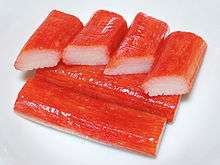Crab stick
 Crab sticks – imitation crab meat surimi. | |
| Alternative names | imitation crab meat, seafood sticks, krab |
|---|---|
| Place of origin | Japan |
| Main ingredients | white fish |
|
| |
Crab sticks, krab sticks, imitation crab meat or seafood sticks are a form of kamaboko, a processed seafood made of starch and finely pulverized white fish (surimi), shaped and cured to resemble the leg meat of snow crab or Japanese spider crab.[1]
History
Sugiyo Co., Ltd. (スギヨ Sugiyo) of Japan first produced and patented imitation crab meat in 1973, as Kanikama. This was a flake type. In 1974, Osaki Suisan Co., Ltd., of Japan first produced and patented imitation crab sticks.
In 1976, The Berelson Company of San Francisco, California, US, working with Sugiyo, introduced them internationally. Kanikama is still their common name in Japan, but internationally they are marketed under names including Krab Sticks, Ocean Sticks, Sea Legs and Imitation Crab Sticks. Legal restrictions now prevent them from being marketed as "Crab Sticks" in many places, as they usually do not have crab meat.[2]
Alaska pollock (Theragra chalcogramma) from the North Pacific is commonly the main ingredient, often mixed with fillers such as wheat, and egg white (albumen)[1] or other binding ingredient, such as the enzyme transglutaminase.[3] Crab flavoring is added (artificial) and a layer of red food coloring is applied to the outside.
See also
References
- 1 2 Laura, Campo-Deano; Clara Tovar (October 2009). "The effect of egg albumen on the viscoelasticity of crab sticks made from Alaska Pollock and Pacific Whiting surimi". Food Hydrocolloids. 23 (7): 1641–1646. doi:10.1016/j.foodhyd.2009.03.013.
- ↑ "What's in a Name: Crabless Crab Legs No Longer Imitation". Wall Street Journal. December 13, 2006. Retrieved August 31, 2010.(subscription required)
- ↑ Gritzer, Daniel (July 22, 2008). "Mystery science eater – Time Out New York". Newyork.timeout.com.
Further reading
| Wikimedia Commons has media related to Kanikama. |
- Imitation crab meat. Retrieved April 18, 2014, from http://www.madehow.com/Volume-3/Imitation-Crab-Meat.html#b
- Seafood Health Facts: Making Smart Choices. Retrieved April 29, 2014 from https://web.archive.org/web/20140509054612/http://seafoodhealthfacts.org:80/seafoodqa/23.php